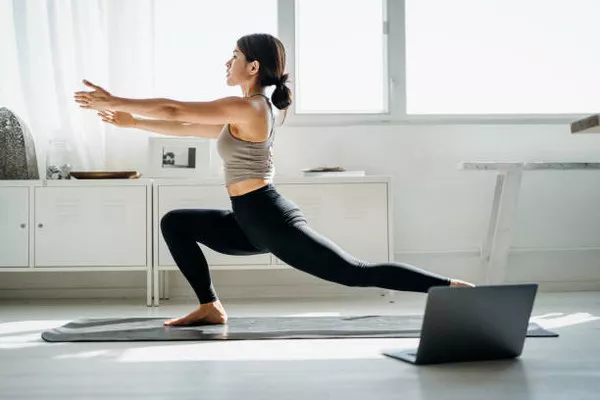Urinary incontinence, the involuntary leakage of urine, often affects older adults but can also impact younger individuals. This condition is especially prevalent among women who have recently given birth or are experiencing menopause. Yoga, an ancient practice renowned for its benefits on physical and mental well-being, may offer a viable solution for managing bladder control. Here are nine yoga poses that can help mitigate urinary incontinence.
The Role of Yoga in Bladder Health
Research indicates that yoga can positively influence bladder health. According to a study published in the Annals of Internal Medicine in August 2024, participants who practiced yoga for 12 weeks experienced a reduction in urinary incontinence episodes by an average of 2.3 per day. This finding underscores yoga’s potential in alleviating the discomfort associated with urinary leakage.
Dr. Hansaji Jayadeva Yogendra, a noted yoga expert, explains, “Regular yoga practice stimulates the pelvic region, enhances blood circulation, and alleviates tension in the bladder area. These benefits contribute to improved bladder control and a decrease in urinary incontinence.”
1. Chakrasana (Wheel Pose)
To perform Chakrasana:
- Stand upright with your arms relaxed by your sides and feet parallel, slightly apart.
- Clench your fists, raise your arms towards your ears, and arch your back, thrusting your hips forward.
- Bend forward, bringing your forehead towards your knees. Swing your arms backward, interlocking your fingers, and extend the bend.
- Hold your breath in this position, then inhale as you return to an upright stance.
This pose enhances flexibility and strengthens the pelvic floor and core muscles, essential for bladder control.
2. Hasta Padangushthasana (Standing Hand-to-Toe Pose)
For Hasta Padangushthasana:
- Stand with your feet together and arms at your sides.
- Lift your right leg towards your shoulder, holding your big toe with your right hand.
- Maintain this position while breathing deeply, then gently release and repeat with the left leg.
This pose improves balance and core strength, supporting the pelvic region.
3. Konasana (Angle Pose)
To practice Konasana:
- Stand with your feet apart, arms raised to shoulder level, palms up.
- Spread your arms and turn your neck to look at your right palm.
- Bend forward and twist to touch your left toes with your right fingers, keeping your left arm extended upward.
- Hold the position with breath suspended, then untwist and return to the starting position. Repeat on the other side.
Konasana stretches the pelvic region and strengthens the lower back and core, aiding bladder control.
4. Bhadrasana (Butterfly Pose)
For Bhadrasana:
- Sit with your legs extended and hands beside your body.
- Bend your knees outward and bring the soles of your feet together, heels close to the perineum.
- Press your knees down and hold the position for 1 to 2 minutes, breathing deeply.
- Release by stretching your legs back to the starting position.
This pose opens the hips and strengthens the pelvic floor, crucial for controlling bladder movements.
5. Paschimottanasana (Seated Forward Bend)
To perform Paschimottanasana:
- Sit with your legs stretched forward, feet together, and spine erect.
- Raise your arms to shoulder level.
- Inhale, bend forward, and try to grasp your toes, pulling them inward.
- Exhale while maintaining the position, then return to the starting stance.
This pose enhances lower back flexibility and strengthens pelvic muscles, essential for bladder control.
6. Pavanmuktasana (Wind-Relieving Pose)
For Pavanmuktasana:
- Lie on your back with feet together and hands beside your body.
- Exhale and bend both legs towards your chest, clasping below the knees.
- Pull the legs closer, holding the position with breath suspended, then release.
This pose relieves tension in the lower abdomen and pelvic area, helping to regulate bladder function.
7. Sarvangasana (Shoulder Stand Pose)
To practice Sarvangasana:
- Lie on your back with feet together.
- Lift both legs straight up, then raise your arms to support your waist and push your body upwards.
- Adjust your hands to support your lower back, shifting weight onto your shoulders.
- Hold the position, then gently lower your hips and legs back to the mat with hand support.
This pose strengthens the core and pelvic floor, improving circulation and bladder control.
8. Ushtrasana (Camel Pose)
For Ushtrasana:
- Kneel on the mat and lean back, placing your arms behind you with fingers on the ground.
- Inhale and lift your pelvis as you push your upper body upwards, letting your neck fall back.
- Hold the position, then return to kneeling.
- Camel pose stretches the pelvic area and enhances strength in the bladder region.
9. Matsyasana (Fish Pose)
To perform Matsyasana:
- Lie on your back with hands beside your body.
- Fold your legs into Sukhasana (easy pose) or Padmasana (lotus pose).
- Draw your hands under your head, bending at the elbows and clasping opposite elbows.
- Maintain the position, breathing rhythmically for 1 to 2 minutes.
- Release by unclasping your hands and unfolding your legs.
This pose improves blood flow to the pelvic region, supporting bladder control.
Conclusion
Incorporating these yoga poses into your daily routine can lead to significant improvements in bladder control. By engaging and strengthening the muscles of the pelvic floor, lower abdomen, and core, yoga offers a natural approach to managing urinary incontinence. Regular practice can help alleviate symptoms and enhance overall bladder health.
Related Topic:


